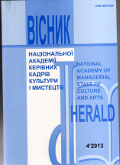Creative activities of song and dance ensemble "Polissya" as a prerequisite of Chernihiv’s region professional choral performance
DOI:
https://doi.org/10.32461/2226-3209.4.2013.138007Keywords:
song and dance ensemble, Chernihiv Philharmonic Society, "Polissya", folk choir, repertoire, bandura, L. BodnarukAbstract
professional choral performance The song and dance ensemble "Polissya” was the first professional choral group in the Chernihiv’s region music culture of the second half of ХХІ century. But investigation of main stages of creative activity of ensemble is not done. The purpose of research is to study the professionalization of Chernihiv’s region folk choral life. The prototype of creation of the song and dance ensemble "Polissya” was Chernihiv culture palace’s amateur choir "Desna”. It was founded in 1951 and has held leading positions in the choral life of Chernihiv region in 1950–1970. Period of the artistic rise of "Desna” was during the second half of the 70’s – early 80’s, when the group worked under the guidance of a Grigory Drahynets. He led the choir to victory in the Ukrainian televised tournament "Soniachny Klarnety”, won a gold medal in the Second and Third All-Union festival of amateur folk art, received diploma of the Presidium of the Verkhovna Rada of Ukraine, Union of Soviet Composers, Chernihiv Oblast Prize named after G. Veryovka etc. The "Desna” headed by the G. Drahynets performed in Chernihiv, Moscow, Minsk, Kaunas, Gomel, Vilnius, Bryansk, Kiev, cities of Siberia; five times "Desna” was on concert tour in Czechoslovakia. So, amateur folk choir "Desna” became a leader in choral life of Chernihiv region. Successful performance of amateur collective "Desna” showed the competitive choral forces of the region. Apparently, this is actualized in the late 1970’s the rationale for their professionalism, which led to the emergence of the idea of the foundation of the song and dance ensemble at the Chernihiv Philharmonic Society. The song and dance ensemble "Polissya” was created at the Chernihiv Philharmonic Society in 1979. The artistic leader and main conductor of the ensemble became Lubomir Bodnaruk; the choreographer of the ensemble became Grigory Horbachuk. The ensemble consists of choral, dancing and orchestra groups. The base of the repertoire of the "Polissya” was the region folk songs of the Ukrainian, Russian and Belarusian Polissya, arrangements of folk songs by A. Avdievsky, G. Veryovka, L. Bodnaruk and others. The main purpose of the initial phase of Lubomir Bodnaruk as the artistic leader and main conductor of the song and dance ensemble "Polissya” was the formation of the group’s own creative style, because for a long time in Ukraine there were many similar ensembles. L. Bodnaruk’s desire could be considered implemented in two main individual features of the "Polissya”. At first, the uniqueness of the ensemble was to use bandura as the main instrument of accompaniment. The use of bandura by the ensemble created the unique coloring of "Polissya”, gave a kind of lyrical sound to the group, a soft timbre, special charm. Secondly, chorus group used exclusively academic manner of singing, which also was not typical for the collectives of this type. Reasons of Lubomir Bodnaruk’s attraction to academic manner of choral singing can be seen in the tradition of Lviv Choir School to which he belonged.Downloads
Published
Issue
Section
License
Authors who publish with this journal agree to the following terms:
1. Authors retain copyright and grant the journal right of first publication with the work simultaneously licensed under a Creative Commons Attribution License International CC-BY that allows others to share the work with an acknowledgement of the work's authorship and initial publication in this journal.
2. Authors are able to enter into separate, additional contractual arrangements for the non-exclusive distribution of the journal's published version of the work (e.g., post it to an institutional repository or publish it in a book), with an acknowledgement of its initial publication in this journal.
3. Authors are permitted and encouraged to post their work online (e.g., in institutional repositories or on their website) prior to and during the submission process, as it can lead to productive exchanges, as well as earlier and greater citation of published work (See The Effect of Open Access).


